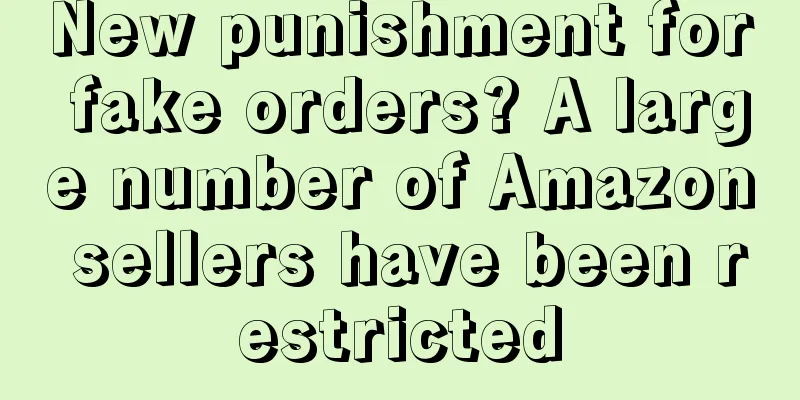Amazon has two major crises! Stores are closed due to scanning numbers, and warehouses have stopped receiving goods

|
With the end of the annual Black Friday and online shopping promotions, many sellers have failed to experience the expected explosive growth. Instead, their profit margins have been greatly compressed amid extended promotion periods and intensified competition on multiple platforms. At this critical moment, Amazon has new developments that have attracted widespread attention in the industry. Sellers are facing a new round of challenges and tests such as "Protocol 3 Video Verification" and "Some warehouses suspension of receiving goods". Just as Black Friday was in full swing, Amazon launched a new round of account review process - video verification in Section 3 of Amazon's Business Solutions Agreement, which caught many sellers off guard. The notification email shows that the account has violated Agreement 3 and needs to undergo virtual verification. If the seller fails to complete the virtual video verification interview through the provided link within 14 days, or the verification is unsuccessful, Amazon will take various severe intervention measures against the account, including account suspension. Amazon said that the main purpose of this video verification is to verify the authenticity of the goods sold by the seller and to check whether there are any illegal account operations. Through video verification, Amazon can understand the actual situation of the seller more directly, thereby ensuring that the goods on the platform are authentic and there are no illegal operations. It is worth noting that the scope of this scanning is a large-scale indiscriminate scanning. Whether it is a new store or an old store, it is possible to receive a video verification notification. According to sellers’ feedback, the video verification process is relatively strict, with detailed and specific questions covering multiple aspects such as accounts, products and supply chains. The verification officer will ask detailed questions such as the legal person’s identity information, credit card/collection account information, brand qualifications, supplier background, etc. If the answer is wrong, the verification may fail. Especially when the legal person’s ability to cooperate is poor, sellers must prepare adequate countermeasures in advance, otherwise the account security will be at risk. // For video verification, sellers need to prepare a series of documents in advance, including but not limited to:
// At the same time, paper documents must be clear and readable so that auditors can verify them on site. Including but not limited to:
Sellers need to take these preparations seriously and have a comprehensive understanding of the business details to ensure the authenticity and completeness of the information to avoid verification failure due to incomplete or incorrect information. In the tense atmosphere of Amazon's Black Friday promotion season, the restart of large-scale scanning and video verification has undoubtedly added new challenges to sellers. At the same time, sellers should also pay attention to the recent problem of Amazon warehouses refusing to accept goods. Recently, many sellers on Amazon US have reported that when they created shipments and filled in the estimated delivery time, the backend system prompted that some warehouses would not be able to receive shipments between December 15 and December 31, and suggested that sellers choose other time periods for shipment. It is reported that a large number of goods poured in during the Black Friday online promotion, and Amazon warehouses were overloaded and could no longer accept more new goods. The suspension involved multiple warehouses in the United States and Europe, all of which experienced varying degrees of delays and warehouse overflows, but the specific warehouses that were suspended still need to be determined by official news. In addition to the above, similar warehouse overflows have also occurred in Amazon warehouses in Vancouver, Japan, Australia, etc. For example, due to warehouse overflows, the difficulty of warehousing in Japan's TY06, TY07, TY08 and TY09 warehouses has increased, and the processing batches of many warehouses can basically only be arranged after mid-December. According to sellers, the list of rejected warehouses has been made public. Sellers need to pay close attention to this list so as to adjust the delivery plan in time to avoid unnecessary losses caused by rejected goods: QXY9, RDG1, SBD3, MGE1, CLT6, XLX6, MIT2, GYR1, BFI3, SWF2, TEB6, LAS1ABE4, BNA2, FTW9, SMF6, OLM1, SBD, FWA4, MEM1, QXY5, BNA2, FTW9, SMF3, GCL2, JOT1, BEU2, GEU3, JOT1, GEU2, GEU5, JBL2, BEU2, BFL4, TEB6, LAS1, ABE4, BNA2, FTW9, SMF6, OLM1, SBD3, XLX6, GYR1, BFI3, SWF2, TEB9, MEN1 , RFD2, MEM1, QXY5/QXY4, BNA2, FTW9, SMF6, OLM1, SBD3, XLX6, GYR1, BFI3, SWF2, TEB9, LAS1, ABE4 Among them, the abnormal warehouses that need special attention include: QXY5, JOT1 : These warehouses are seriously overwhelmed and often delete reservations without reason, causing the status of scheduled shipments to become "pending", with a rejection rate as high as 80%. LGB8 : Due to warehouse overflow, the appointment times for many in-transit shipments have been continuously postponed. RFD2, GEU5 : Serious liquidation, few contracts released and many rejections. Regarding the reminder that Amazon warehouses cannot receive any shipments between December 15 and December 31, Amazon's official customer service replied: The seller support team has not received any official notification about this policy. What is known now is that due to the busy warehouse, deliveries during this period will be refused entry, and corresponding policies may be issued later to improve information related to delivery and performance. We still need to wait for official notification. Sellers need to pay close attention to cope with the impact and challenges brought by the Amazon warehouse crisis to their business. The subsequent development trend still needs further observation and follow-up. In addition, it is recommended that sellers make stocking plans in advance and try to complete the warehousing of goods before December 15 to ensure that the goods can be put on the shelves for sale in time. |
<<: Amazon Black Friday ended in a "tragic" way! Sellers: I really can't roll with it anymore
>>: Black Friday sales increased 13 times! A large number of sellers found a new traffic entrance!
Recommend
Insights into the US beauty products market: 5 trends to watch out for in 2023!
According to the latest research from eMarketer, d...
Amazon warehouses continue to be seriously overstocked! Starting from June 27, self-delivery products will usher in changes!
Amazon Prime Day is approaching, and the things t...
Temu surpasses Shein in the US, but still cannot compete with Amazon
It is learned that according to foreign media repo...
[DNY123 Cross-border Morning News] Apple Pay enters Malaysia, TikTok Shop jewelry and crystal stores are free to enter!
Tuesday, August 16 《DNY123》>>>Cross-borde...
Etsy announcement: Sellers can increase product exposure through new Google features!
It is learned that on November 14, Etsy, the large...
Even with the price increase, how addicted are Americans to Amazon Prime?
According to foreign media reports, there are curr...
Discover Amazon's hottest trending products! Come and mark this 2021 peak season product selection guide
Now that the 2021Q4 peak season is getting closer,...
Announcement! Amazon's fees have increased
The first-leg freight has increased, the product ...
Walmart, Target, Walgreens and Best Buy Ranked Among the Top 50 Companies in the United States!
Walmart, Target, Walgreens and Best Buy are among...
Many big sellers are selling at low prices! Zebao is demanding 1 billion from the founder!
▶ Video account attention cross-border navigation ...
Things to note when complaining to Amazon customers about non-genuine products
Because most sellers generally do not require supp...
What is the Amazon Marketplace Professional Services Program? Amazon Marketplace Professional Services Program Review
The Amazon Marketplace Professional Services Progr...
To avoid congestion at US ports, Amazon wants to buy used Boeing cargo planes and import them from China!
It is learned that according to foreign media repo...
Amazon’s new feature “Call me now” triggers complaints?
Amazon recently released a new announcement on its...
What is IReviewHome? IReviewHome Review
IReviewHome is a discount-for-review website run b...









